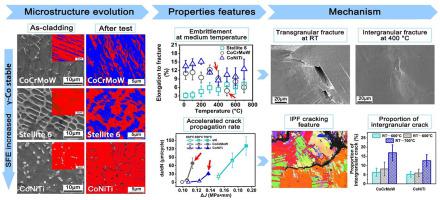Materials Science and Engineering: A ( IF 6.1 ) Pub Date : 2022-10-03 , DOI: 10.1016/j.msea.2022.144135 Ying Wu , Guisheng Zou , Yan Liu , Zhanwen A , Wenzheng Zhao , Wengan Wang , Junliang Xue , Yongxin Zhang , Qiang Jia , Hui Chen

|
A new cobalt-based coating, CoNiTi, was developed for brake disc applications. The effect of temperature on the tensile and thermal fatigue cracking properties of CoNiTi was evaluated between room temperature (RT) and 700 °C, and compared with those of the commercial CoCrMoW and Stellite 6 coatings. The strength of all coatings decreased with increasing test temperature, and the elongation to fracture of Stellite 6 increased with increasing test temperature. However, CoNiTi and CoCrMoW presented deterioration in elongation to fracture at 400–500 °C. In addition, the crack propagation rate of CoCrMoW and CoNiTi also presented a trend of accelerated increase under RT ∼700 °C thermal fatigue condition. By combining the finite element simulation of thermal fatigue and in-situ tensile test, the grain boundary weakness at middle temperature was revealed to clarify the reason for the deterioration of plasticity and crack growth resistance in CoCrMoW and CoNiTi. The microstructure evolution of γ-Co → ε-Co martensitic transformation during tests depended on the temperature and chemical composition associated with stacking fault energy (SFE). Increasing temperature and nickel content could improve SFE, stabilize γ-Co, and make dislocation glide in cross-slip mode, on the contrary, γ-Co tended to undergo martensitic transformation, and the dislocation was in planar-slip mode, when SFE was low.
中文翻译:

用于制动盘应用的激光沉积钴基涂层的拉伸和热疲劳开裂性能的温度依赖性
为制动盘应用开发了一种新的钴基涂层 CoNiTi。在室温 (RT) 和 700 °C 之间评估温度对 CoNiTi 的拉伸和热疲劳开裂性能的影响,并与商用 CoCrMoW 和 Stellite 6 涂层进行比较。所有涂层的强度随着试验温度的升高而降低,而Stellite 6的断裂伸长率随着试验温度的升高而增加。然而,CoNiTi 和 CoCrMoW 在 400–500 °C 时的断裂伸长率下降。此外,CoCrMoW和CoNiTi的裂纹扩展速率在RT~700 ℃热疲劳条件下也呈现加速增加的趋势。通过将热疲劳的有限元模拟与原位拉伸试验相结合,揭示了中温晶界弱点,以阐明 CoCrMoW 和 CoNiTi 塑性和抗裂纹扩展性劣化的原因。显微结构演变γ -Co → ε -Co 马氏体转变在测试过程中取决于与堆垛层错能 (SFE) 相关的温度和化学成分。提高温度和镍含量可以改善 SFE,稳定γ -Co,使位错以交叉滑移模式滑移,相反,当 SFE 加入时,γ -Co 倾向于发生马氏体相变,位错处于平面滑移模式。低的。











































 京公网安备 11010802027423号
京公网安备 11010802027423号